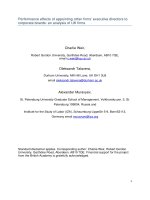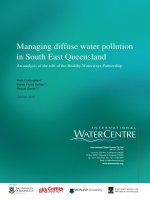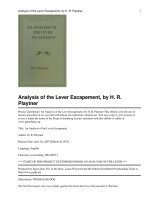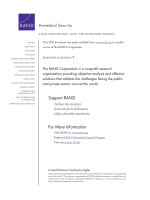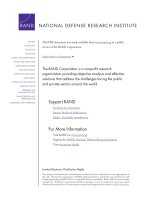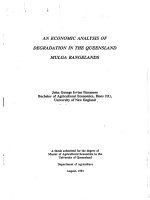An analysis of the role of microfinance in promoting financial inclusion in india
Bạn đang xem bản rút gọn của tài liệu. Xem và tải ngay bản đầy đủ của tài liệu tại đây (2.79 MB, 386 trang )
AN ANALYSIS OF THE ROLE OF MICROFINANCE PROGRAMS IN
PROMOTING FINANCIAL INCLUSION IN INDIA
SAVITA SHANKAR
NATIONAL UNIVERSITY OF SINGAPORE
2011
AN ANALYSIS OF THE ROLE OF MICROFINANCE PROGRAMS IN
PROMOTING FINANCIAL INCLUSION IN INDIA
1
SAVITA SHANKAR
(M.B.A., Faculty of Management Studies, Delhi University)
A THESIS SUBMITTED FOR THE DEGREE OF DOCTOR OF
PHILOSOPHY
LEE KUAN YEW SCHOOL OF PUBLIC POLICY
NATIONAL UNIVERSITY OF SINGAPORE
2011
1
The rupee exchange rate is approximately Rs. 45.50 to a US Dollar (February 14, 2011).
i
Acknowledgments
I have been fortunate in receiving generous help and support from various quarters throughout
the course of researching for the thesis. At the outset, I would like to express my gratitude to the Lee
Kuan Yew School of Public Policy (LKYSPP) for providing me an opportunity to pursue my PhD at the
school. The excellent facilities and stimulating academic environment at the School helped me
immensely. I am also thankful for the research scholarship provided by the School.
I am grateful to my thesis supervisor, Professor Mukul Asher for his patience, support and
guidance throughout the course of my PhD study. His contribution was indeed far more than required
of him as the thesis supervisor. He has been a source of great encouragement and has been
instrumental in improving my thesis through his insightful suggestions. I would like to express my
gratitude to Professor Charles Adams, member of the thesis committee, for his analytical insights
which were invaluable in enabling me to develop my research framework. He was kind enough to read
and comment on various drafts of the thesis. Professor Dodo J.Thampapillai, member of the thesis
committee, also kindly reviewed various drafts of the thesis and provided many useful suggestions.
I take this opportunity to thank my teachers at LKYSPP, Professor Wu Xun, Professor M.
Ramesh and Professor Scott Fritzen who through their excellent courses helped in developing my
thinking on the research topic. In addition, I very much appreciate the contribution of Professor
Bhanoji Rao for providing guidance on broader aspects relating to economic development. I would
like to thank Professor Darryl Jarvis for his comments on an early draft of the research proposal
which were very helpful. I would also like to acknowledge the contribution of Ms. Ruth Choe,
Associate Director and PhD Coordinator at the LKYSPP for her excellent support throughout the PhD
ii
course. I am also thankful to my colleagues in the PhD program, especially Alex, Michael, Seck, Allen,
Ching and Bali, who made my PhD experience a very pleasant one.
I am grateful to Grama Vidiyal Microfinance Limited (GVMFL) for permitting me to carry out
interviews of field workers and microfinance members of GVMFL. Ms. D. Shirley, Director, Mr. Arjun
Muralidharan, Chief Executive and other employees were generous in sharing their knowledge and
sparing their time for the study. I very much appreciate that the GVMFL officials recognized the need
to undertake the study in the manner which rigorous empirical research required. I would like to
acknowledge the help of Ms. Kalpana Sankar, Managing Trustee, Mr. N.Jeyaseelan, Chief Operating
Officer of Hand in Hand (HIH) India for permitting me to interview HIH microfinance member. They
too recognized the requirements of rigorous empirical research.
I wish to mention here the invaluable contribution of the microfinance members who
participated in the study, enriching it beyond measure. I was touched by their willingness to share their
experiences in a forthright manner and their determination to improve their lot despite their
constraints.
I would like to acknowledge the support of my parents who have always encouraged me to
achieve whatever I wanted. My husband, Shankar, has been very supportive and helpful in enabling me
to focus on my research. My daughters, Vibha and Varsha, deserve a special "thank you" for their
understanding regarding my preoccupation with my studies, their interest in tracking the “word
count” progress of my thesis and the innumerable good luck charms they showered me with.
While all the above have contributed to the thesis, the usual caveat that I am responsible for
errors, applies here too.
Savita Shankar
February 16, 2011
iii
Table of Contents Page Number
THESIS ABSTRACT vii
LIST OF TABLES ix
LIST OF FIGURES x
LIST OF BOXES xi
LIST OF CHAPTER APPENDICES xii
LIST OF ANNEXURES xiii
LIST OF ABBREVIATIONS xiv
CHAPTER 1 INTRODUCTION 1
1.1 Motivation for the Thesis 2
1.2 Financial Inclusion 6
1.3 Measures of Financial Inclusion 10
1.4 Barriers to Financial Inclusion 13
1.5 Policies to promote Financial Inclusion: An International Overview 18
1.6 Research Questions 27
1.7 Organization of the thesis 28
CHAPTER 2 A REVIEW OF THE MICROFINANCE LITERATURE 32
2.1 Challenges in providing credit to low income groups 33
iv
2.2 The Microfinance Sector Growth: Three Waves 39
2.3 Features of microcredit 43
2.4 Main Debates in the Microfinance Literature 57
2.5 Evaluation of MFIs 64
2.6 Graduation of Microfinance group members to 76
Individual financial services
2.7 The Microfinance Sector: Regulatory Issues and Practices 83
2.8 Concluding Remarks 86
CHAPTER 3 RESEARCH FRAMEWORK AND METHODOLOGY 91
3.1 Framework for analyzing financial inclusion 91
3.2 Research Questions 96
3.3 Research Design and Method 99
3.4 Data Sources and Collection 102
3.5 Cases at Microfinance Provider Level 108
3.6 Cases at Microfinance Member level 113
3.7 Research Details 115
3.8 Data Analysis 118
3.9 Limitations of the Study 120
3.10 Concluding Remarks 120
v
CHAPTER 4 SECTOR LEVEL ENQUIRY: MICROFINANCE 131
SECTOR IN INDIA
4.1 The Self Help Group Bank Linkage Program (SBLP) Model 132
4.2 The MFI Model 141
4.3 Differences between the SBLP Model and MFI Model 154
4.4 Microfinance in Tamil Nadu 156
4.5 Sector Level Enquiry: Barriers to Financial Inclusion 161
4.6 Sector Level Enquiry: Outcomes of Financial Inclusion 174
4.7 Sector Level Enquiry: Graduation to Individual Financial Services 198
4.8 Concluding Remarks 200
CHAPTER 5 MICROFINANCE PROVIDER AND MEMBER LEVEL 225
ENQUIRIES: AN ANALYSIS OF RESULTS OF
EMPIRICAL STUDY
5.1 Profile of Respondents 225
5.2 Barriers to Financial Inclusion 228
5.3 Outcomes of Financial Inclusion 238
5.4 Graduation to individual financial services 256
5.5 Analysis of cases at Microfinance Provider Level 262
5.6 Analysis of cases at the member level 265
5.7 Building a framework for financial inclusion through microfinance 267
vi
5.8 Concluding Remarks 269
CHAPTER 6 A SUGGESTED FRAMEWORK FOR MICROFINANCE 291
REGULATION
6.1 Present Arrangements for Microfinance Regulation in India 293
6.2 Unique challenges of microfinance regulation 300
6.3 Current regulatory structure in India 305
6.4 Proposed Model for Microfinance Regulation in India 312
6.5 Concluding Remarks 316
CHAPTER 7 SUMMARY, POLICY IMPLICATIONS AND DIRECTIONS 329
FOR FUTURE RESEARCH
REFERENCES 344
ANNEXURES 362
vii
Thesis Abstract
The thesis defines financial inclusion as ongoing access to a range of financial services in an
affordable and convenient manner. As low income groups are often among those lacking such access,
microfinance programmes providing financial services to them have emerged as a public policy
instrument to promote financial inclusion. This thesis evaluates the contribution of microfinance
programs in promotion of financial inclusion in India.
The research framework and research questions in the thesis were informed by the relevant
literature, particularly relating to microfinance, financial inclusion and their links with broader
development goals. The research questions relate to how the two major microfinance models in India,
the self help group bank linkage program (the SBLP) and the microfinance institution (MFI) model,
address barriers to financial inclusion, and facilitate expected outcomes.
To sustain financial inclusion, group microfinance members should graduate to individual
financial services. The thesis therefore also explores the environment in which such graduation could
take place.
A research design based on case studies and qualitative research methods was adopted. The lines of
enquiry followed were at the sector level, at the microfinance provider level and at the microfinance
member level. For the provider and member levels, primary data were collected in the State of Tamil
Nadu. At the provider level, one organization associated with each model was studied, including
interviews of senior officials and 103 MFI field staff. At the member level, 34 low income women
viii
were interviewed. The enquiry enabled the development of an explanatory framework for financial
inclusion through microfinance.
The research at the sector level led to understanding of the following: factors influencing
microfinance penetration; requirement for improving availability of financial services other than
microcredit; need for creating a sector wide credit bureau; benefits of unique identification numbers for
residents to facilitate development of credit histories for microfinance members; and the importance of
a systematic approach to graduation of group members to individual financial services.
The findings from provider and member level research included barriers to microfinance
membership; the requirement for a wider range of financial services particularly savings services; and
the need for enhanced financial literacy and financial management skills among members. Distinct
categories of MFI and SBLP members also emerged. “Effective utilizers” who build up individual
repayment capability during group membership, enabling them to graduate to individual loans later,
were common to both models. In addition, in MFIs, there were “ineffective utilizers” who fail to
adequately build up repayment capacity. In the SBLP, there were “cashflow smoothers” and
“consistent savers”. While the first do not receive adequate finance in order to invest substantially in
their enterprises, the second group uses the SBLP primarily to save.
The thesis analyzed appropriate regulatory framework for the microfinance sector. The study
has implications for policymakers at the national and state level, microfinance providers, members and
funding agencies. The thesis findings also suggest that there is considerable scope for policy relevant
empirical research on microfinance in India.
ix
LIST OF TABLES
1. Relevant Situations for Different Research Strategies. 101
2. Data Sources and Methods of data collection 107
3. Comparison of Indian MFIs with MFIs in Select Countries 151
4. Comparison of SBLP Model and MFI Model 154
5. Microfinance Penetration in India 163
6. Population per bank branch in Indian States 170
7. Matrix on Availability of Microfinance and Banking Services 171
8. Selected Indicators of Microinsurance in India 178
9. Features of microinsurance schemes in India 215
10. Composition of Interviews at Member Level 228
11. Field Officers’ Responses: Main reasons for Individuals 232
not being able to join microfinance groups
12. Field Officers’ Responses: Main reasons causing members 235
to drop out
13. Main Products Requested by Members 242
x
LIST OF FIGURES
Figure 1.1 Barriers to Financial Inclusion 18
Figure 2.1 The Vicious Cycle of Poverty 53
Figure 2.2 How Microcredit can break the Vicious Cycle 53
Figure 3.1 Process of Financial Inclusion 92
Figure 3.2 Financial Inclusion framework developed by CENFRI 93
Figure 3.3 Outcomes of Financial Inclusion 95
Figure 3.4 Framework for analyzing Financial Inclusion 96
Figure 3.5 Financial Inclusion Roadmap 98
Figure 4.1 Growth in Outreach of SBLP Model (2002-09) 137
Figure 4.2 Growth in Outreach of MFI Model (2002-09) 150
Figure 4.3 Location of Tamil Nadu 158
Figure 4.4 Map of Tamil Nadu 159
Figure 4.5 Distribution of Microfinance of Microfinance and Banking 173
Services across states in India
Figure 5.1 Explanatory framework for financial inclusion through 267
Microfinance
xi
LIST OF BOXES
Box 1.1: India Post: Avenue for Provision of Financial Services 30
Box 1.2: The National Rural Employment Guarantee Act 31
Box 2.1: The Compartamos Controversy 89
Box 3.1: The “Below Poverty Line” List 122
Box 3.2: Qualitative research and Quantitative research: Major Characteristics 123
Box 4.1: The SKS Story 205
Box 5.1: Reasons for not being able to join a microfinance group 270
Box 5.2: Reasons for dropping out of microfinance groups 271
Box 5.3: Continuous MFI membership, continuous borrowing 272
Box 5.4: The extraordinarily high and low contributors at household level 273
Box 5.5: Using loans as a means to save 274
Box 5.6: Consistent saver in SBLP 275
Box 5.7: Costs of mismatches between MFI loans and member needs 276
Box 5.8: Feeling the Need for individual loans 277
Box 6.1: Malegam Committee Report on Microfinance Sector 319
xii
LIST OF CHAPTER APPENDICES
Appendix 3.1 Sector Stakeholders Interviewed 124
Appendix 3.2 GVMFL: Details of board of directors 127
Appendix 3.3 Hand in Hand India: Details of board of directors 129
Appendix 4.1 Insurance Density and Insurance Penetration 207
of Select Countries
Appendix 4.2 Microinsurance Schemes in India 208
Appendix 4.3 Micro-pension Plans in India 217
Appendix 5.1 Demographic profile of Interviewees 278
Appendix 5.2 Samples of Cashflows of MFI member 288
households
Appendix 6.1 Interest Rates in Microfinance 321
Appendix 6.2 Features of different legal forms adopted by MFIs 325
xiii
List of Annexures
Annexure 1: Sample Questions for Discussion with MFP Senior Personnel 361
Annexure 2: Sample Questions for MFP Field Personnel 363
Annexure 3: Sample Questions for Discussion with MFP Member 365
xiv
LIST OF ABBREVIATIONS
AP Andhra Pradesh
ATM Automated Teller Machine
BC Banking Correspondent
BRI Bank Rakyat Indonesia
CCE Citizen Centre Enterprises
CGAP Consultative Group to Assist the Poor
CRA Community Reinvestment Act
DFI Development Finance Institution
ERR Effective Rate of Return
FINCA Foundation for International Community Assistance
FIPB Foreign Investment Promotion Board
GDP Gross Domestic Product
GPS Grameen Pension Scheme
GRT Group Recognition Test
GVMFL Grama Vidiyal Microfinance Limited
HIH Hand in Hand India
IFAD International Fund for Agricultural Development
IFI Index of Financial Inclusion
IRDA Insurance Regulatory and Development Authority
IRDP Integrated Rural Development Program
IRR Internal Rate of Return
IT Information Technology
xv
KYC Know Your Customer
MACs Mutually Aided Cooperative Society
MFI Microfinance Institution
MFO Microfinance Organisation
MFP Micro Finance Provider
MFIN Microfinance Institutions Network
MIX Microfinance Information Exchange
MPI Microfinance Penetration Index
MPPI Microfinance Poverty Penetration Index
NABARD National Bank for Agriculture and Rural Development
NBFC Non-banking finance company
NBFI Non Bank Financial Institution
NGO Non-governmental Organization
NREGA National Rural Employment Guarantee Act
NSSO National Sample Survey Organization
OB Oversight Board
PFRDA Pension Fund Regulatory and Development Authority
RBI Reserve Bank of India
ROSCA Rotating Savings and Credit Associations
RRB Regional Rural Bank
SHG Self Help Group
SBLP Self Help Group Bank Linkage Program
SLBC State Level Bankers’ Committee
xvi
UN United Nations
1
1. Introduction
Microfinance refers to the provision of a broad range of financial services such as
deposits, loans, money transfers, and insurance to poor and low income households and
their microenterprises
1
. Provision of microcredit, namely loans for the poor, has however
dominated the microfinance sector globally.
The growth of microfinance has been described as a revolution (Robinson, 2001).
Yunus (1998) has described it, perhaps somewhat exaggeratedly, as a “revolutionary way
to reduce poverty”
2
. The first Microcredit Summit held in Washington D.C., in 1997,
brought together over three thousand people from 137 countries. It was organized by
RESULTS
3
Educational Fund. The Summit launched a nine year campaign to reach over
100 million of the world‟s poorest families
4
. The year 2005 was designated by the United
Nations (UN) as the “International year of microcredit”. In 2006, the Nobel Peace Prize
was awarded to Muhammad Yunus, the founder of Grameen Bank, one of the earliest and
1
Definition from Asian Development Bank web site (www.adb.org, accessed on November 1, 2008).
Microenterprises here are assumed to be non-financial in nature.
2
Rigorous evaluation studies have however yet to establish conclusively the link between microfinance and
poverty reduction. Refer Chapter 2 for a detailed review of studies on microfinance impact.
3
RESULTS (not an acronym) is a grassroots based advocacy group headquartered in the USA.
4
The goal is reported to have been reached by year 2007, when a new goal of reaching 175 million poorest
families and lifting 100 million families above the threshold of US$ 1 a day by 2015 was adopted by the
Summit (Daley-Harris, 2009).
2
perhaps the best known microfinance institution (MFI). These milestone events have
drawn international attention to the microfinance sector.
One of the most important potential contributions of microfinance is financial
inclusion, namely enabling access of financial services to underserviced individuals.
This chapter explains the rationale for the thesis and the research questions. It also
provides an overview of the concept of financial inclusion and its link with microfinance.
Section 1.1 explains the rationale for the study. Section 1.2 introduces the concept of
financial inclusion while Section 1.3, 1.4 and 1.5 provide an international overview of
measures of financial inclusion, barriers to financial inclusion and policies for the
promotion of financial inclusion, respectively. Section 1.5.1 discusses financial inclusion
policy in India. Section 1.6 specifies the research questions and finally Section 1.7
describes the organization of the thesis.
1.1 Motivation for the Thesis
In India, financial inclusion (discussed in greater detail in Section 1.2) has been
on the policy agenda since financial year 2004-2005, after being highlighted in the annual
policy review of the country‟s central bank, the Reserve Bank of India (RBI). According
to the “All India debt and investment survey”, (2003), the share of institutional debt for
rural households in India in 2002 was 57 percent, declining from 64 percent in 1991
5
5
The share of institutional sources had earlier increased from 29 percent in 1971 to 61 percent in 1981 with
expansion in the network of state owned banks and further to 64 percent in 1991.
3
(NSSO,2005). In 2005, assuming one savings account per person, 59 percent of the adult
population in India had bank savings accounts. The number of loan accounts, on the other
hand, constituted only 14 percent of the adult population (Thorat, 2007).
An inclusive financial system implies availability of a continuum
6
of financial
services for all income groups. Financial inclusion policies of most countries typically
focus on encouraging banks to open affordable savings accounts for the financially
excluded
7
. The assumption is that once this is achieved, access to other financial services
becomes easier. However in the Indian context, it is observed that such accounts, even
when opened are not widely used and substantive financial inclusion therefore remains
limited
8
.
Various studies indicate that low income acts as a significant barrier to financial
inclusion, both from the demand and the supply side
9
. This makes provision of financial
services to low income segments of the population particularly challenging. Microfinance
specifically addresses this very segment, making such programs very useful in promoting
6
The term “continuum” is used to imply that there are no gaps in provision of financial services. To
illustrate with an example regarding loans, if MFIs provide loans up to a certain amount, loans just above
that threshold need to be provided by another kind of institution. There should not be a gap between the
upper threshold of the MFI and the lower threshold of the institution providing the next larger loan.
7
The term “financially excluded” implies individuals who are unable to access financial services due to the
presence of barriers. This is the sense in which the term is largely used in the financial inclusion literature.
There is no normative implication attached to the term.
8
This aspect is discussed in detail in Section 1.5.1.
9
Section 1.4 discusses this aspect in detail.
4
financial inclusion. As Rhyne (2010) puts it “financial inclusion is like a jigsaw puzzle,
for which microfinance has many of the pieces”
10
.
With the rapid growth of the microfinance sector in India, there were 70 million
microfinance accounts by 2009, indicating an annual growth rate of 25 percent. The
sector is attracting finance from a variety of sources and hence is growing at a rapid pace.
As microfinance programs in India typically cater to low income financially excluded
households, it is fast emerging as a possible means to expand access.
An understanding of the contribution of microfinance programs and their service
gaps from the financial inclusion perspective can indicate additional facilitative and
supportive roles required of the Government and other stakeholders. As detailed in
Chapter 2, many studies on microfinance tend to focus on its possible impact in
enhancing various socially desirable objectives, such as poverty mitigation and female
empowerment. The results of these studies have mostly been inconclusive. While there is
consensus on microfinance‟s utility in providing financial services, there is no in-depth
analysis on this aspect.
An important gap in the literature concerns the examination of the question
whether microfinance adequately addresses demand and supply side barriers, mentioned
in the literature on financial inclusion. Conroy (2006) and Jayasheela et al. (2010)
suggest that microfinance can be a useful means of increasing financial inclusion in the
10
This was mentioned in her article urging MFIs to focus on financial inclusion by expanding the range of
financial services offered by them, as their current over-emphasis on expanding the scale of their lending
operations has led to concerns regarding multiple lending and repayment problems in a number of
countries.
5
context of the Pacific Islands and India respectively, but not on the basis of detailed
studies. Further, while there is considerable literature on financial development and
economic growth at the macro level
11
, no other study examines if outcomes expected of
financial inclusion are provided by microfinance at the individual level. Similarly, no
other study analyzes whether group membership subsequently enables graduation of
microfinance members to financial services on an individual basis.
The thesis attempts to evaluate the contribution of microfinance programs to
financial inclusion based on primary data collected in the state of Tamil Nadu in India.
The microfinance sector in this state is at a mature level, though there is scope for further
progress. Not all states in India exhibit a mature microfinance sector, nevertheless the
results of a study focused on Tamil Nadu could provide an indication of typical issues
that are likely to arise in other states as microfinance access grows. An important finding,
which is likely to be relevant for the rest of the country, is the need to develop an
appropriate regulatory framework for the microfinance sector. A suggested framework
for the country as a whole is articulated in the thesis as state level regulation could be
dysfunctional, creating distortions in the spread of microfinance services.
11
These studies are described in Section 1.2.
6
1.2 Financial Inclusion
There is recognition that in countries at all income levels, there are population
groups that are not adequately serviced by the formal financial system. Financial
inclusion involves expanding their access to the financial system at an affordable cost.
Early definitions of financial exclusion viewed it in the larger context of social
exclusion. Leyshon and Thrift (1995) define financial exclusion processes as those which
serve to prevent certain social groups and individuals from gaining access to the formal
financial system. More recently, financial inclusion has been defined by the World Bank
(2008), as the absence of price and non-price barriers in the use of financial services.
The UN report (2006) entitled, “Building inclusive financial sectors for
development”
12
(referred to sometimes as the “blue book”) played a significant role in
bringing international attention on this issue. The publication was a follow-up to the
Monterrey Consensus in 2002, under which heads of State resolved to address the
challenges of financing for development.
The U.N. Report defines an inclusive financial system as one which provides
credit to all “bankable” individuals and firms; insurance to all insurable individuals and
firms; and savings and payment services for everyone. Financial inclusion does not imply
that everyone will use all available financial services, rather everyone has the option to
use them. An important distinction made in the U.N. Report is between “inclusive
12
The book is available online at:
[Accessed
on 2 November 2009].
7
finance” and microfinance. While the former refers to a broader concept of a continuum
of financial service providers, the latter represents only one type of financial sector
organization. Building inclusive sectors hence includes, but is not limited to,
strengthening microfinance. A continuum of financial services needs to be made
accessible to individuals as they improve their standard of living.
Often small and medium enterprises which have outgrown microfinance are
unable to access and use mainstream financial products. These enterprises are usually
unable to find financiers to cater to their requirement, a gap known as the “missing
middle”
13
. While the UN Report advocates a vision for financial inclusion, it does not
provide specific policy prescriptions. However it does emphasize that within a country,
multiple stakeholders need to work together in a coordinated manner if progress towards
financial inclusion is to be made (Page 40, Executive Summary of the UN Report).
Expected Outcomes of Financial Inclusion
The importance of financial inclusion stems from various factors. First, an
inability to access financial services could lead financially excluded entities to deal
mostly in cash, with its attendant problems of safe-keeping. Second, the lack of access to
safe and formal saving avenues could reduce their incentives to save. When saving
occurs, safety and interest rate benefits may not be adequate to the extent available in the
formal system. Inadequate savings could lead households to depend on external sources
of funds, in times of need. Often these sources are unregulated and with high interest
13
The gap is supposed to have first been identified by a commission headed by Harold MacMillan in the
United Kingdom in the 1930s (Burgess, 2010).


